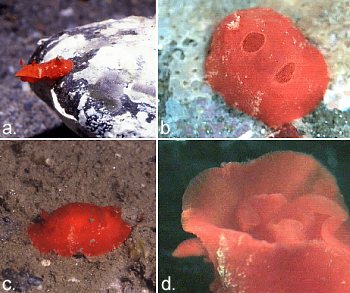
Aldisa smaragdina
Ortea, Perez & Llera, 1982
Order: NUDIBRANCHIA
Suborder: DORIDINA
Superfamily: EUDORIDOIDEA
Family: Dorididae
DISTRIBUTION
Mediterranean and nearby Atlantic coasts
PHOTO
A, Specimen 18 mm long alive. Cantarriján, Almuñecar, Granada, Spain. Depth 5m. 14 June 2002. B, Specimen 5 mm long alive. Cantarriján, Almuñecar, Granada, Spain. Depth 5m. 3 March 1999. C, Specimen 20 mm long alive. Velilla, Almuñecar, Granada, Spain. Depth 9m. 14 October 1996. D, Underside of anterior end showing flattened triangular oral tentacles. Photos: Luis Sanchez Tocino.
There seems to be some confusion in the identity of the species of Aldisa from the Mediterranean and surrounding seas. There seem to be at least two red species with two darker spots on the back, and white transverse marks across the mantle.
•Aldisa banyulensis Pruvot-Fol 1951 is said to have 8 gills and feeds on Hemymicale columella. It is small growing 8-12mm long
•Aldisa smaragdina Ortea, Perez, Llera 1982] grows to 30mm long and feeds on Anchinoe fictitius.
There is a third species, with very similar colour pattern, Aldisa expleta Ortea, Perez & Llera, 1982, but it lacks the two median dark spots on the dorsum. In the most recent revision of the genus, Millen & Gosliner (1985) say the situation is very confused and I can only agree. They consider Aldisa smaragdina to be a synonym of the earlier Aldisa binotata Pruvot-Fol, 1953. One problem is that A. binotata was poorly described, with no information on its anatomy. The single specimen on which the species is based is lost, so cannot be re-examined. The name Aldisa smaragdina continues to be used by European workers, presumably because there is no consensus on whether A. binotata is recognisable.
A. smaragdina, like A. banyulensis is red or orange-red with some white streaks on the mantle skirt. The mantle is pustulose and there are two darker pits in the dorsal midline between the gills and the rhinophores. The two differ in a number of external features. The rhinophores in A. smaragdina have few lamellae and they are arranged almost vertically while in A. banyulensis the more numerous lamellae are arranged horizontally. The gills in A. smaragdina are whitish in the upper half and red basally while in A. banyulensis they are a translucent red with no major white pigmentation. The rhinophore pockets in A. smaragdina have a series of tubercles around the edge and the gill pocket is strongly crenulate. In comparision, the edges of these pockets in A. banyulensis are smooth. Another more difficult difference to see is the shape of the head. In A. smaragdina the oral tentacles are slightly enrolled and bluntly cut off at the end, while in A. banyulensis they are triangular and flattened, with a pointed end. Both species have red eggs but they are larger [200µm diam] in A. banyulensis than in A. smaragdina [130µm].
References:
• Garcia, F.J., Garcia-Gomez, J.C. & Cervera, J.L. (1986) Ridescrizione di Aldisa banyulensis Pruvot-Fol, 1951 (Mollusca: Gastropoda: Nudibranchia). Lavori della Societe Italiana di Malacologia, 22: 97-110.
• Millen, S.V. & Gosliner, T.M. (1985) Four new species of dorid nudibranchs belonging to the genus Aldisa (Mollusca: Opisthobranchia), with a revision of the genus. Zoological Journal of the Linnean Society, 84: 195-233.
• Ortea, J.A., Perez, J.M. & Llera, E.M. (1982) Moluscos opistobranquios recolectados durante el plan de bentos circuncanario. Doridacea: primera parte (1). Cuadernos del Crinas, 3: 1-48.
• Pruvot-Fol, A. (1951) Etudes des nudibranches de la Mediterranee. 2. Arch. Zool. Exp. Gen., 88(1): 1-8O. (Pls. 14)
• Pruvot-Fol, A. (1953) Etude de quelques opisthobranches de la cote Atlantique du Maroc et du Senegal. Travaux de l'Institute Scientifique Cherifien, Zoologie, 5: 1-105. (Pls. 1-3)
Rudman, W.B., 2002 (November 11) Aldisa smaragdina Ortea, Perez & Llera, 1982. [In] Sea Slug Forum. Australian Museum, Sydney. Available from http://www.seaslugforum.net/find/aldismar
Related messages
Aldisa smaragdina from southern Portugal
June 26, 2006
From: Carlos Afonso
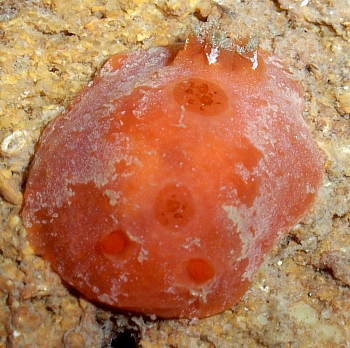
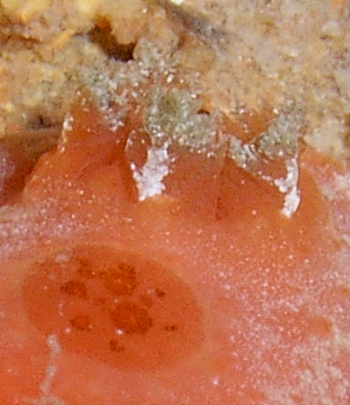
Dear Bill,
Here are some photos of Aldisa smaragdina collected just a few days ago between the localities of Albufiera and Armação de Pêra (Algarve, South Portugal). The specimen came from a depth of 20 meters and was found attached under rock set on platform.
Locality: Between Albufiera and Armação de Pêra , 20 meters, Algarve, Portugal, Atlantic Ocean, 20 June 2006, found attached under rock set on rock platform with sand. Photographer: Carlos Afonso (Lab. photo).
Warm regards,
Carlos Afonso
(Algarve, South Portugal)
cmlafonso@ualg.pt
Afonso, C., 2006 (Jun 26) Aldisa smaragdina from southern Portugal. [Message in] Sea Slug Forum. Australian Museum, Sydney. Available from http://www.seaslugforum.net/find/16971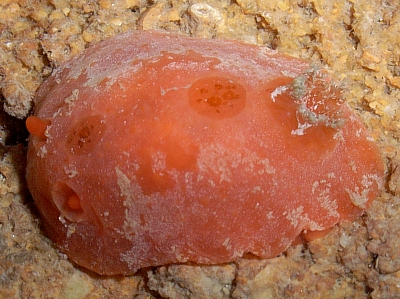
Dear Carlos,
Thanks for these photos. They show how the upper half of the gills is a whitish colour, and the lower half reddish, which seems to be a character of this species. They also show the two dark patches in the dorsal midline between the gills and the rhinophores, which is a feature of many species of Aldisa. The dark patches seem to be an attempt to camouflage the nudibranch to look like a sponge, as these dark patches look quite like the large pores or oscules in sponge colonies which are part of its water circulation system.
Best wishes,
Bill Rudman
Aldisa smaragdina - radular morphology
November 20, 2002
From: Luis Sanchez Tocino
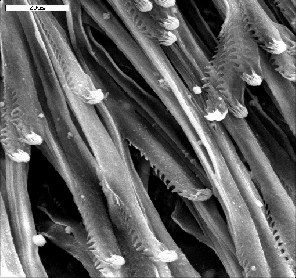
Dear Bill,
To accompany my earlier message, here are some photos to show the radular morphology of Aldisa smaragdina
Scale bars: Upper right = 20µm; Lower left = 20µm; Lower right = 5µm
Best wishes,
Luis
lstocino@ugr.es
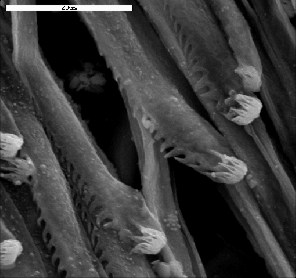
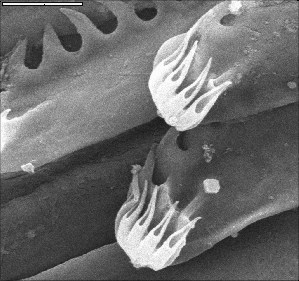
Thanks Luis,
Bill Rudman
Aldisa smaragdina - mantle spicules & penial spines
November 20, 2002
From: L. S. Tocino
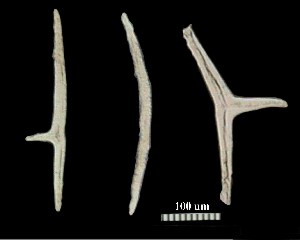
Dear Bill,
To accompany my earlier message, here are some photos to show some other aspects of the anatomy of Aldisa smaragdina.
Upper right: some spicules from the mantle - spicule length approx 1mm.
Lower photos: showing penis and penial spines at various magnifications. Scale bar = 50µm in each case.
Best wishes,
Luis
lstocino@ugr.es
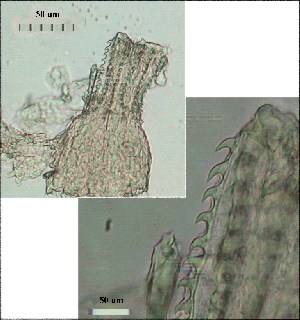
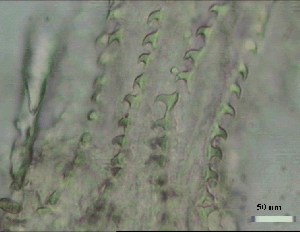
Thanks Luis,
Bill Rudman
Aldisa smaragdina from Spain (1)
November 13, 2002
From: Luis Sanchez Tocino

Dear Bill,
Here are some photos of Aldisa smaragdina. The photos of Aldisa smaragdina in Alma Sánchez's message are actually of A. banyulensis. I have sent photos of the tubercles in a separate message.
To help compare this species with Aldisa banyulensis here are some measurable details which differ between the two species.
18mm long - 6 gills - 7 rhino lamellae
13mm long - 5 gills - 9 rhino lamellae
10mm long - 6 gills - 7 rhino lamellae
A, Specimen 18 mm long alive. Cantarriján, Almuñecar, Granada, Spain. Depth 5m. 14 June 2002. B, Specimen 5 mm long alive. Cantarriján, Almuñecar, Granada, Spain. Depth 5m. 3 March 1999. C, Specimen 20 mm long alive. Velilla, Almuñecar, Granada, Spain. Depth 9m. 14 October 1996. D, Underside of anterior end showing flattened triangular oral tentacles. E,F. Lateral and posterior view of rhinophore. G,H. Lateral and dorsal view of gills. Photos: Luis Sanchez Tocino.
Best wishes,
Luis
lstocino@ugr.es
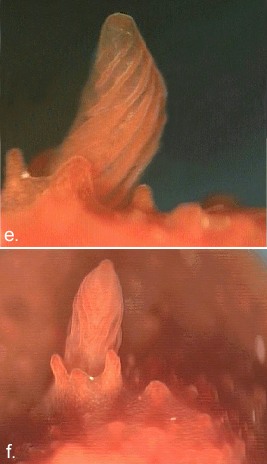
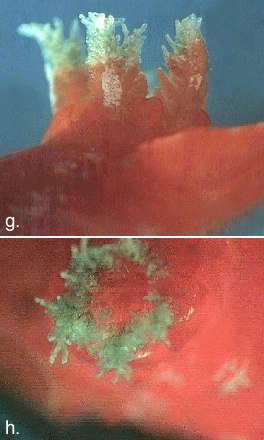
Thanks Luis,
These photos of A. smaragdina and the photos you have sent separately of Aldisa banyulensis are helpful in differentiating between these two species. However I still would be interested to know about the differences between A. smaragdina and A. binotata.
Best wishes,
Bill Rudman
Aldisa smaragdina from Spain (2)
November 13, 2002
From: Luis Sanchez Tocino
Dear Bill,
Here are some SEM photos of the mantle of Aldisa smaragdina to accompany my earlier message. Left: Scale bar = 500µm. Right: Section through tubercle. Scale bar = 200µm.
Best wishes,
Luis.
lstocino@ugr.es
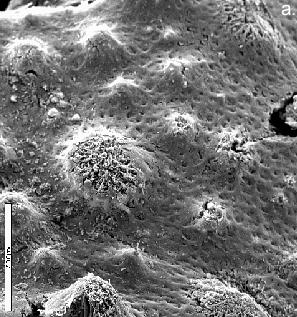
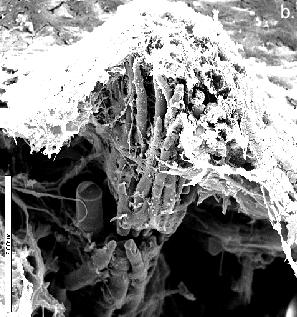
Thanks Luis,
Bill Rudman
Re: Aldisa? from the Canary Islands
May 24, 2001
From: Erwin Köhler
Dear Bill,
Concerning the Aldisa from the Canary Ids. It has been identified by Leopoldo Moro Abad as Aldisa smaragdina Ortea, Perez & Llera, 1982
Cheers
Erwin
Erwin@medslugs.de
Koehler, E., 2001 (May 24) Re: Aldisa? from the Canary Islands. [Message in] Sea Slug Forum. Australian Museum, Sydney. Available from http://www.seaslugforum.net/find/4344Thanks Erwin,
It's nice to get another one off the unidentified page. I had left it there in the hope of getting some advice on whether Aldisa smaragdina was considered the same as Aldisa binotata as suggested by Millen & Gosliner. Any comments gratefully received.
Best wishes,
Bill Rudman
Aldisa? from the Canary Islands
March 30, 2001
From: Erwin Koehler
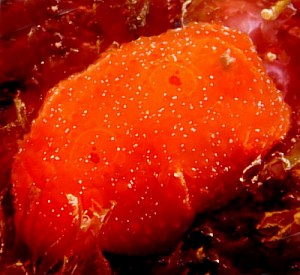
Dear Bill,
Here is the next one from the Canary Islands, taken by Arthur J. Telle,
email: mercedes@idecnet.com
size 6-7mm, depth 0.5m, Gran Canaria Island
Is it Aldisa?
Erwin
Erwin@medslugs.de
Koehler, E., 2001 (Mar 30) Aldisa? from the Canary Islands. [Message in] Sea Slug Forum. Australian Museum, Sydney. Available from http://www.seaslugforum.net/find/4049I would agree that this is probably a species of Aldisa from the red colour and the two darker spots between the gills and the rhinophores. I thought this should be easy to identify but a look at the literature suggest a bit of confusion in the species of Aldisa from the Mediterranean and surrounding seas. There seem to be at least two red species with two darker spots on the back, and white transverse marks across the mantle.
•Aldisa banyulensis Pruvot-Fol 1951 is said to have 8 gills and feeds on Hemymicale columella. It is small growing 8-12mm long
•Aldisa binotata Pruvot Fol 1953 [= Aldisa smaragdina Ortea, Perez, Llera 1982] grows to 30mm long and feeds on Anchinoe fictitius
Millen & Gosliner (1985) say the situation is very confused and I can only agree. So some advice from local experts would be welcome.
• Millen, S.V. & Gosliner, T.M. (1985) Four new species of dorid nudibranchs belonging to the genus Aldisa (Mollusca: Opisthobranchia), with a revision of the genus. Zoological Journal of the Linnean Society, 84: 195-233.
Best wishes,
Bill Rudman
